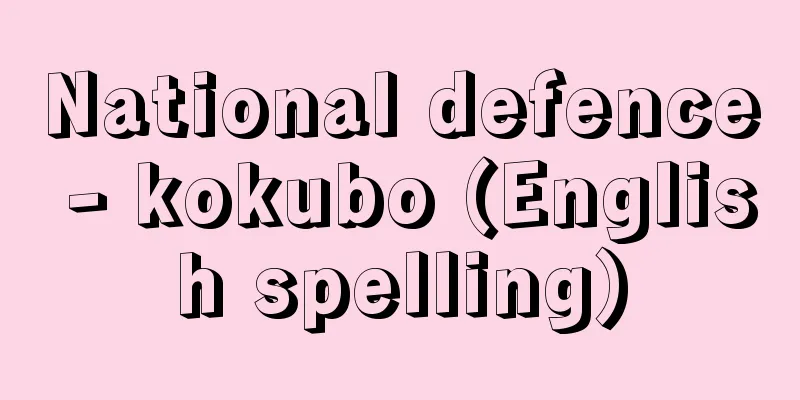National defence - kokubo (English spelling)

|
Defending the country with all its strength against armed aggression. Generally, threats to national security are said to come from outside and from inside. Threats can be either military or non-military, and the means of responding to them can also be military or non-military. The concepts of national defense, national security, and defense are used according to combinations of these. Defense is the use of military power to protect the country against external military threats. National defense also targets military threats, but the means used to achieve this are not limited to military power, but include the nation's total strength, including politics, diplomacy, economy, science and technology, and psychology. In other words, in terms of the means of responding, national defense has a broader scope than defense. Therefore, national defense also includes the development of the defense industry by the Ministry of Economy, Trade and Industry and the construction of military roads by the Ministry of Land, Infrastructure, Transport and Tourism. The "Basic Policy for National Defense," decided by the National Defense Council and the Cabinet on May 20, 1957, sets out the purpose and basic policy of national defense. The Ministry of Defense is responsible for defense, while the Security Council (established in 1986 after the abolishment of the National Defense Council) is responsible for national defense. The fact that the Security Council includes the Minister for Foreign Affairs, the Minister for Finance, and the Minister of State for Economic and Fiscal Policy as members shows the diversity of means to respond to threats. National security covers both military and non-military threats, and refers to maintaining the safety of the country through military and non-military means, including threats from within the country. [Haruo Fujii] [References] | |Source: Shogakukan Encyclopedia Nipponica About Encyclopedia Nipponica Information | Legend |
|
武力侵略に対し国の総力をあげて国を防衛すること。一般に、国家の安全に対する脅威としては、外部からのものと内部からのものがあるとされる。また脅威の態様としては、軍事的なものと非軍事的なものがあり、さらに、これに対応する手段にも軍事的・非軍事的なものがある。これらの組合せによって、国防、国家安全保障、防衛の概念が使用されている。外部からの軍事的脅威に対し軍事力をもって国を守ることを防衛(ディフェンス)という。国防(ナショナル・ディフェンス)は、同じく軍事的脅威を対象とするが、そのために使用する手段は軍事力だけでなく、政治、外交、経済、科学技術、心理など国の総力である。つまり対応する手段の面で、国防は防衛より範囲が広い。したがって国防には、経済産業省が防衛産業を育成したり、国土交通省が軍事道路をつくることも含まれる。1957年(昭和32)5月20日、当時の国防会議と閣議で決定された「国防の基本方針」は、国防の目的と基本方針を示している。防衛省は防衛について、安全保障会議(1986年に国防会議を廃止して新設)は国防について所掌する。安全保障会議が外務大臣、財務大臣、経済財政政策担当大臣を議員に含んでいることは、脅威に対応する手段の多様性を示すといえよう。国家安全保障(ナショナル・セキュリティ)は、軍事・非軍事にわたる脅威を対象とし、軍事的・非軍事的手段をもって国の安全を保つことをいい、国内からの脅威をも対象としている。 [藤井治夫] [参照項目] | |出典 小学館 日本大百科全書(ニッポニカ)日本大百科全書(ニッポニカ)について 情報 | 凡例 |
>>: National Treasure - Kokuhou
Recommend
Taketoyo [town] - Taketoyo
A town in Chita County facing Chita Bay in the cen...
Acts in matters of state
Under the old constitution, the Emperor was the s...
Editor (Information Science) - Editar
…Just as literacy in everyday language refers to ...
Vierwaldstätter See (English spelling)
…the name of a canton (state) and its capital tha...
West Highland white terrier [breed] (English spelling)
A domestic dog that originated in the UK. It is a ...
MRI
(3) MRI a.The device applies radio waves in a stat...
Minamikoizumi ruins
Located in Tomizuka 1-2-chome and Furushiro 3-chom...
ODA - Official Development Assistance
Official Development Assistance. This refers to g...
Book - Book
〘Noun〙① A type of screen. A general term for fabri...
Civil Rights Movement
A social movement that was launched by African Am...
Penzance (English spelling)
A town in west Cornwall, in the southwestern tip o...
Kamakura Highway - Kamakura Highway
It is a general term for the old roads leading to...
freeverse
…The term is a direct translation of the English ...
Ambushure - Ambushure
... To play, place your lips halfway over the mou...
Rosetta
...Population 37,000 (1966). Also known as Rosett...









